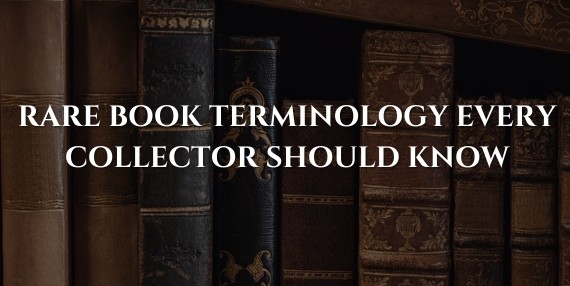Rare Book Terminology Every Collector Should Know
Entering the world of rare books is like entering a different realm. The world of magic, wonder and fascinating tales of bygone times. It is also a world filled with new terms and words that you might not have encountered before.

Navigating The World of Rare Books
Navigating the world of rare book auctions can be thrilling — and intimidating. Whether you’re a seasoned collector or a newcomer eyeing your first buy, or looking to diversify your investments, understanding rare book terminology is essential. Without it, you risk overpaying, misunderstanding condition reports, or missing out on hidden gems. These unique book terms are used by collectors, sellers, and dealers to establish a standard and uniformity, making it easier to identify authentic books. These aren’t just fancy words — they’re shorthand for a book’s condition, edition, rarity, and overall value. Think of it as a glossary of literary terms that helps decode the marketplace. Not just knowing but understanding this book terminology will help you on your journey of collecting these treasures. So, before you enter and bid at a rare book auction, read and understand this glossary of book terms. With our rare book glossary guide, we will explore the important book terminology you need to know before your next auction to buy with confidence and clarity.
Also Read: Ultimate Guide to Rare Book Collecting
How Book Terminology Helps You Buy Smarter
When bidding at auction, every word in a catalogue entry matters. Terms like “first edition”, “facsimile”, or “ex-library” can dramatically affect a book’s price and collectibility. The condition description alone can make or break a deal.
Understanding these book terms helps you:
- Spot authenticity quickly
- Avoid overpaying for flawed or altered copies
- Compare listings and assess value accurately
- Bid with confidence, not guesswork
This rare book glossary is your edge — a real-world tool for decoding the language of auctions and stepping into the arena like a pro.
Also Read: Timeless Charm of Rare Books
Glossary of Book Terms

Below is a carefully selected list of essential rare book terminology — from condition grades to binding styles. These terms appear in nearly every rare book auction catalogue or dealer listing.
PART 1: Book Condition Terms
Understanding book condition terminology is non-negotiable at auction. These terms directly affect price, desirability, and collectibility. A book can be a first edition and signed — but if it’s in poor condition, its value drops sharply.
-
Fine (F)
Pristine condition. No defects, likely unread, and as close to new as possible. Rare for older books.
-
Near Fine (NF)
Minor flaws like light shelf wear or faint discolouration, but still highly collectible.
-
Very Good (VG)
Some signs of use or age: rubbed edges, small tears, or faint foxing. Still complete and solid.
-
Good (G)
Well-worn with visible damage but still intact. Reading copy quality. Only desirable if the book is very rare.
-
Fair / Poor
Major flaws — torn pages, loose binding, missing parts. Only considered collectible if extremely scarce.
-
Foxing
Reddish-brown spots or blotches caused by moisture or paper acidity. Common in antique books. Affects aesthetics more than structure.
-
Ex-Library
Previously owned by a library. Expect stamps, stickers, or card pockets. Generally, less collectible unless exceptionally rare.
-
Rebound
The original cover has been replaced. Increases durability but usually lowers collector value — unless rebounded by a notable binder.
PART 2: Aesthetic and Style Terms
These book aesthetics and physical characteristics affect collectibility, historical significance, and display value. Understanding these terms will help you judge quality and originality at a glance.
 1. Dust Jacket (DJ)
1. Dust Jacket (DJ)
Dust Jackets are the printed paper covers. Especially important for 20th-century books. Often more valuable than the book itself if original.
- Clipped: Price on flap has been cut off — lowers value.
- Unclipped: Price still intact — preferred.
- Facsimile DJ: Reproduction dust jacket — not original.
-
Binding
Binding explains how the book is physically put together and what covers it.
- Quarter-bound: Spine in one material (often leather), boards in another.
- Half-bound: Spine and corners in one material, boards in another.
- Full-bound: Entire cover is the same material — often cloth or leather.
- Calf Bindings: Leather bindings using calf hide
- Morocco Bindings: Another type of binding that has been used since the 1500s. They often have colourful dyes and are made of goatskin.

3. Gilt Edges
Gold-leafed page edges. A luxury finish that protects and decorates. May also include decorative stamping on covers or spine.
All Edges Gilt (A.E.G.)
The top, fore-edge and foot of the book are coloured in gold
-
Hinge
Where the cover connects to the spine. A tight hinge means structural integrity. A cracked hinge may reduce value or usability.
-
Uncut / Unopened
- Uncut: Pages not trimmed at the bindery. Aesthetic feature.
- Unopened: Pages still joined together, unread.
-
Colophon
A note at the end of the book — often in limited editions — indicating the publisher, printer, and sometimes edition number or artist.
Part 3: Book Format and Size Terms
The traditional terms in use for describing book formats, which are derived from early printing methodology and the size of early handmade sheets of paper
- Folio – more than 13 inches tall.
- Quarto (4to) – approx. 10 to 13 inches tall, average 12 inches.
- Octavo (8vo) – approx. 8 to 10 inches tall, average 9 inches.
- Duodecimo (12mo) – approx. 7 to 8 inches tall, average 7.5 inches.
- Sexto decimo (16mo) – approx. 6 to 7 inches tall, average 6.5 inches.
Part 4: General Terms
-
First Edition
A first edition in book collecting is the first published version of a book. Collectors prize it for its originality and historical importance. However, not all first editions are first printings — some go through multiple print runs. Always verify the points of issue that distinguish a true first.
-
Limited Edition
A limited edition is printed in a restricted quantity, often numbered and signed. These editions are sometimes privately distributed or part of a special release. Value depends on scarcity, quality, and demand.
-
Signed Copy
A signed copy contains the author’s signature. If personalized or inscribed to a significant individual, it may be labelled an association copy, which can carry a higher price tag.
-
Presentation Copy
A presentation copy is given by the author, often with a personal inscription. Like association copies, they are often more desirable than generic signed copies.
-
Provenance
Provenance refers to a book’s ownership history. A documented chain of ownership — especially involving notable figures — increases credibility and value. It can also offer insights into the book’s journey through time.
-
Facsimile
A facsimile is a replica — not the original. Facsimile pages or jackets are reproductions and reduce collector value. Some sellers clearly state this, while others bury it in the description.
Tip: “facsimile dust jacket” = not original. Major drop in value.
Bid with Confidence
By mastering this glossary of book terms, you give yourself a serious advantage at auctions. Understanding these details isn’t optional — it’s essential. It allows you to bid smarter, avoid costly mistakes, and recognize when a book is truly special.
Before your next auction, revisit this rare book glossary. Make it part of your research routine. Because when you’re investing in rare books — whether for passion, profit, or both — language is power.






